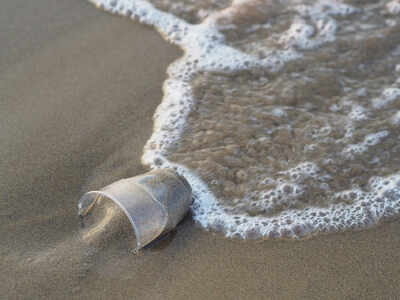
CHENNAI: A national-level effort is on to curb disposal of plastic in the ocean. Now, a team from the city-based National Centre for Coastal Research (NCCR) has come up with an alternative idea to put plastic back in the ocean to develop an underwater habitat for marine life.
The idea is simple: Pick up plastic debris from landfills and the sea, segregate and melt them. Apply a thick coat on natural hard substrate like rock and put them back on the seabed for growth of tiny marine organisms like algae to reef-building corals that can protect the coast from natural disasters.
This, say scientists, can help recycle plastic. “We have not implemented it completely. We will conduct field tests in the Gulf of Mannar and, based on the results, we will implement it,” said NCCR director M V Ramana Murthy. While floating plastics pose a threat to marine life, underwater studies have also shown that various plastics like nets, ropes, buoys and rubber tyres settled on the seabed support the growth of diverse marine algae, particularly the reef building crustose coralline algae and other invertebrates.
Meanwhile, as India works on a national marine litter policy to clean up oceans, researchers across the country have started conducting studies along the 7,500km coastline to identify the source of litter flowing into India’s coastal waters. According to International Union for Conservation of Nature (IUCN), at least eight million tonnes of plastic go into oceans every year. In India, studies have shown that six lakh tonnes of plastic waste is dumped annually.
NCCR, through its field office in Mandapam, has been monitoring the health of corals along the 21 islands in the Gulf of Mannar.
Over the years, they have recorded cases of bleaching and death. After a back to back global bleaching event in 2016 and 2017, they recorded nearly 16% coral death and another 23% bleaching.
The team involving T Shunmugaraj, S Koushik and C H Ramesh also devised an alternative methodology. Instead of melting the plastic, they could be simply be wound around hard substrates. However, in both the methodologies, researchers have recommended several rounds of tests to check the safety of plastic coating in oceans.
The idea is simple: Pick up plastic debris from landfills and the sea, segregate and melt them. Apply a thick coat on natural hard substrate like rock and put them back on the seabed for growth of tiny marine organisms like algae to reef-building corals that can protect the coast from natural disasters.
This, say scientists, can help recycle plastic. “We have not implemented it completely. We will conduct field tests in the Gulf of Mannar and, based on the results, we will implement it,” said NCCR director M V Ramana Murthy. While floating plastics pose a threat to marine life, underwater studies have also shown that various plastics like nets, ropes, buoys and rubber tyres settled on the seabed support the growth of diverse marine algae, particularly the reef building crustose coralline algae and other invertebrates.
Meanwhile, as India works on a national marine litter policy to clean up oceans, researchers across the country have started conducting studies along the 7,500km coastline to identify the source of litter flowing into India’s coastal waters. According to International Union for Conservation of Nature (IUCN), at least eight million tonnes of plastic go into oceans every year. In India, studies have shown that six lakh tonnes of plastic waste is dumped annually.
NCCR, through its field office in Mandapam, has been monitoring the health of corals along the 21 islands in the Gulf of Mannar.
Over the years, they have recorded cases of bleaching and death. After a back to back global bleaching event in 2016 and 2017, they recorded nearly 16% coral death and another 23% bleaching.
The team involving T Shunmugaraj, S Koushik and C H Ramesh also devised an alternative methodology. Instead of melting the plastic, they could be simply be wound around hard substrates. However, in both the methodologies, researchers have recommended several rounds of tests to check the safety of plastic coating in oceans.
World Cup 2019
Trending Topics
LATEST VIDEOS
More from TOI
Navbharat Times
Featured Today in Travel
Quick Links
Lok Sabha Election Schedule 2019Lok Sabha Election NewsDelhi Capitals teamMI team 2019Rajasthan Royals 2019RCB team 2019Maharashtra Lok Sabha ConstituenciesBJP Candidate ListBJP List 2019 TamilnaduShiv Sena List 2019AP BJP List 2019Mamata BanerjeeBJP List 2019 MaharashtraPriyanka GandhiBJP List 2019 KarnatakaAMMK Candidate List 2019BJP List 2019 WBLok Sabha Elections in Tamil NaduBSP List 2019 UPNews in TamilLok Sabha Poll 2019Satta Matka 2018PM ModiMahagathbandhanNagpur BJP Candidate ListChandrababu NaiduTamil Nadu ElectionsUrmila MatondkarNews in TeluguMadras High CourtTejashwi YadavArvind KejriwalTejasvi SuryaPawan KalyanArvind KejriwalYogi AdityanathJaya PradaSatta King 2019Srinagar encounter
Get the app









